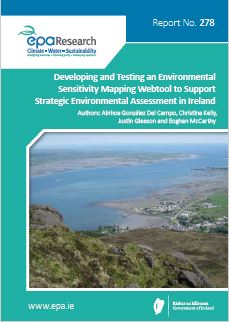Research 278: Developing and Testing an Environmental Sensitivity Mapping Webtool to Support Strategic Environmental Assessment in Ireland
Authors: Ainhoa González Del Campo, Christina Kelly, Justin Gleeson and Eoghan McCarthy
Summary: Environmental sensitivity is a critical consideration in natural resource management. In the context of the legislative requirements for impact assessment, environmental sensitivity (or vulnerability) assessments present a framework for systematically determining the potential for significant adverse impacts.

Identifying Pressures
This report and the associated Environmental Sensitivity Mapping (ESM) webtool, developed by the research team, are a response to the need to enhance consistency and transparency in Strategic Environmental Assessment (SEA) practice. For SEA to effectively inform planning processes, a systematic and accessible approach that provides clear information and ensures comparability between assessments is key. Development pressures on the landscape need to be efficiently examined and the potential for cumulative effects on the environment need to be considered. The output of this research enables the creation of environmental sensitivity maps that capture the accumulated concentration of sensitive environmental features on the landscape, which help to address some of these challenges and direct development to suitable locations. Tight assessment time frames, the need to consider disparate and multiple data sources, and engaging stakeholders and the general public require significant effort by consultants and plan makers. The developed ESM webtool addresses some of these time and resource pressures and provides an opportunity to streamline assessments by centralising information, facilitating public participation, enabling creation of plan-specific maps and providing a robust evidence base to inform spatial planning.
Informing Policy
This research informs policy through the ESM webtool, as it can serve as an empirical and systematic approach and as a more objective critical foundation to promote informed impact assessment and planning. The research outputs promote best practice in the implementation of EU directives and reinforce consideration of their obligations. More specifically, the outputs contribute to improving the effectiveness of SEA, Environmental Impact Assessment and appropriate assessment through the provision of a systematic and evidence-enabling online tool. This results in improved compliance with national sustainability objectives through better, more transparent and evidence-based assessment of plans and programmes that set the basis for projects. In addition, it inculcates a culture of excellence among plan and programme makers and SEA teams, encouraging more than legal compliance (through the incorporation of environmental sensitivity analysis, for example), and contributes to the implementation of the INSPIRE Directive through data exchange and sharing, as well as to the Aarhus Convention and e-governance strategies on access to environmental information.
Developing Solutions
The webtool provides an invaluable resource for SEA by facilitating access to multiple spatial datasets in a single interface (datasets that, prior to the publication of the webtool, were accessible through multiple sources and websites). This saves SEA consultants, local authorities and governmental departments, among others, a lot of time and effort in SEA and planning processes. It also provides a platform for the general public and stakeholders to explore environmental and planning considerations, and it can serve as an educational tool. The webtool contains novel functionality: it is the first online geoprocessing tool that enables the creation of context-specific
maps by anyone, without the need for any technical geographic information system skills. This tool allows the user to combine datasets and incorporate public perceptions in a participatory way, creating plan-specific environmental sensitivity maps. These maps graphically and meaningfully highlight potential sensitivities, pointing to where development would need to be carefully considered and sensitively planned. In this way, the maps can inform sectoral planning discussions and decisions for developing alternatives that avoid or minimise potentially incompatible or unsustainable zonings. The webtool has been tested by the research team in a number of case studies, including real-life settings, namely as part of live SEAs of the National Planning Framework and the Regional Spatial and Economic Strategies. This piloting has verified the usability of the webtool and the veracity of the output maps. Users have confirmed that it contributes to assessment consistency and transparency.
https://www.epa.ie/media/epa-2020/publications/research/Research_278_Thumbnail[1].jpg